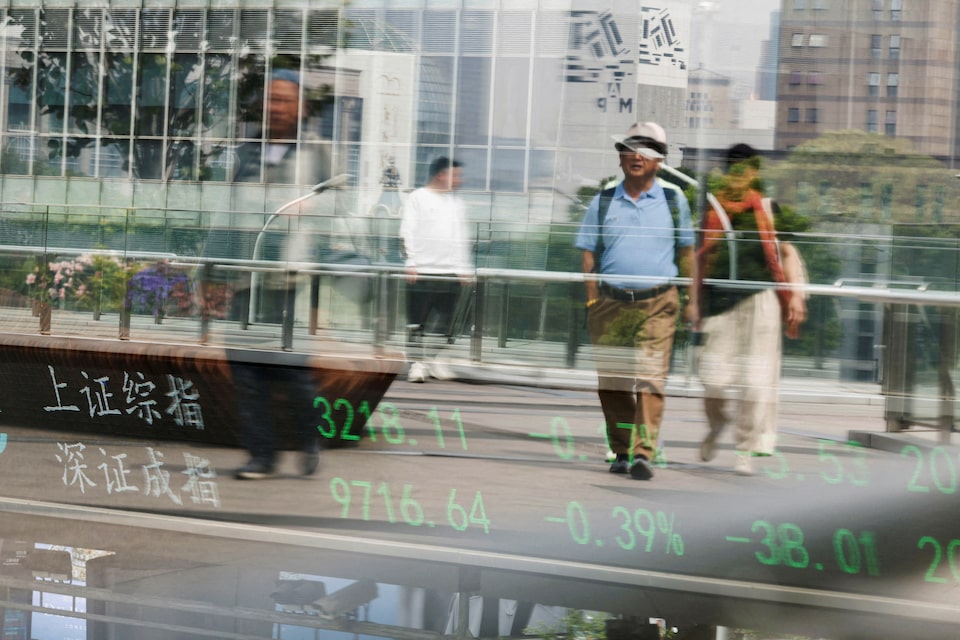An electronic board shows Shanghai and Shenzhen stock indices as people walk on a pedestrian bridge at the Lujiazui financial district in Shanghai, China April 11, 2025. REUTERS

Valdis Dombrovskis, trade commissioner for the European Union (EU), speaks with a specialist trader on the floor at the New York Stock Exchange (NYSE) in New York City, U.S., April 28, 2025. REUTERS
Summary
- Concerns over global growth outlook undermine market mood
- Oil tumbles more than 1%
- China’s factory activity falls sharply as Trump tariffs bite
- Dollar set for worst month in over two years
SINGAPORE, April 30 (Reuters) – Shares struggled for direction on Wednesday and oil prices slid as relief over a potential easing of global trade tensions was upset by a worsening economic outlook and signs corporates were feeling the pain from Donald Trump’s tariffs.
Nasdaq futures were down 0.67% in Asia, while S&P 500 futures fell 0.5%. EUROSTOXX 50 futures slipped 0.06%.
In China, data showed factory activity contracted at the fastest pace in 16 months in April, as hefty U.S. tariffs snapped two months of recovery and kept alive calls for further stimulus from Beijing.
“The hit from sky-high U.S. tariffs meant the new export orders index dropped back to its lowest level, COVID-19 disruptions aside, since August 2012,” said Zichun Huang, a China economist at Capital Economics.
“The sharp drop in the PMIs likely overstates the impact of tariffs due to negative sentiment effects, but it still suggests that China’s economy is coming under pressure as external demand cools.”
The dismal figures hobbled a rise in Chinese shares, with the CSI300 blue-chip index reversing earlier gains to last trade 0.07% lower. Hong Kong’s Hang Seng Index (.HSI), ticked up 0.1%.
Despite Trump’s move to soften the blow of his auto tariffs and signs of progress in broader trade negotiations, details remain scant, with Commerce Secretary Howard Lutnick saying he had reached one deal with a foreign power.
Adding to the tariff anxiety, investors were also grappling with deteriorating U.S. data as Trump’s hefty tariffs rippled across businesses and consumers at home.
“We raise the probability of a prolonged economic stagnation in the coming months, meeting the criteria for a recession, to 50%,” said David Kohl, chief economist at Julius Baer.
“The rising probability of economic stagnation in the U.S. is entirely due to the exogenous forces of an erratic and restrictive economic policy with arbitrary tariffs, disruptions to public spending, changing incentives, and an unsustainable fiscal stance.”
Oil prices extended their steep losses from the previous session on worries about global growth and its impact on demand.
Brent crude futures were down 1.17% to $63.50 a barrel, having tumbled 2.4% overnight. U.S. crude lost 1.36% to fetch $59.60 per barrel.
Data on Tuesday showed the U.S. trade deficit in goods widened to a record high in March as businesses stockpiled ahead of Trump’s tariffs, suggesting trade was a large drag on economic growth in the first quarter. First quarter GDP data is due later in the day.
U.S. consumer confidence also slumped to a nearly five-year low in April.
The precarious state of the global economic outlook, particularly in the United States, left Wall Street futures struggling to sustain gains made during the cash session overnight.
MSCI’s broadest index of Asia-Pacific shares outside Japan was up 0.6%.
The Nikkei tacked on 0.32%.
The fallout from Trump’s trade war reverberated further throughout the corporate world as delivery giant UPS said it would cut 20,000 jobs to lower costs, while General Motors pulled its outlook and delayed its investor call, joining a list of companies that have ditched forecasts for 2025 or slashed outlooks.
“You start to see companies…making some statements about low visibility, the unwillingness or inability to sign long-term contracts, to make long-term plans – that’s a very slippery slope,” said Fabiana Fedeli, M&G’s chief investment officer of equities, multi-asset and sustainability at a media roundtable on Monday.
DATA DUMP
U.S. growth figures aside, the release of the core PCE price index – the Fed’s preferred measure of inflation – is also due later on Wednesday, ahead of jobs data at the end of the week.
Payrolls are seen rising 130,000 and inflation is expected to ease, but there is much more uncertainty about GDP with the median forecast for a meagre 0.3% annualised growth.
Markets are now pricing in 97 basis points worth of rate cuts from the Fed by December, up from about 80 bps early last week.
That has in turn pushed U.S. yields down, with the two-year Treasury yield hitting a three-week trough of 3.6400%. The benchmark 10-year yield bottomed at 4.1580%, also its lowest since early April.
In the foreign exchange market, the dollar was on track for its worst monthly performance since November 2022 with a 4.7% loss, as erratic U.S. trade policies under Trump left the greenback vulnerable.
On the other hand, the yen – a beneficiary of safe-haven demand – was set for a monthly gain of more than 5%, the most since July 2024. Similarly, the euro was headed for its largest monthly gain in over two years and last bought $1.1380.
The Aussie last traded 0.5% higher at $0.6415.
Data on Wednesday showed core inflation in Australia slowed to a three-year low in the first quarter, supporting the case for another cut in interest rates in coming weeks.
Elsewhere, spot gold fell 0.15% to $3,310.55 an ounce.
Reporting by Rae Wee; Editing by Shri Navaratnam and Sam Holmes





